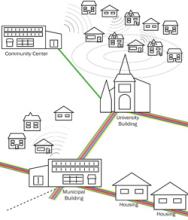
Fast, affordable Internet access for all.


The story has been updated to fix errors. The original story described the project as a partnership but we have since learned it is a project of the Kitsap Public Utility District that is encouraged by the City.
We reported on Poulsbo, Washington, last fall after the community began a wireless pilot project providing a free high-capacity wireless mesh network throughout downtown. Kitsap Public Utility District is running the project, with encouragement from the City. An interview with Poulsbo City Council member Ed Stern filled in more details on this local project.
A wireless mesh pilot project was not the original plan. The public utility district had been investing in a fiber optic network to reduce costs for local government and provide better broadband for schools and hospitals. Stern and other city leaders also recognized that encouraging telecommuting would keep local dollars in the community. Poulsbo is very close to Seattle and city leadership hoped to draw employees from Seattle offices and encourage economic development. They offered a high quality of life and knew better broadband would draw more employers to Poulsbo.
The partners installed a fiber backbone throughout the city and had planned to expand last mile connections in the near future. Poulsbo also codified changes in conduit policy with new ordinances to better manage public rights-of-way. The code requires private providers to first use existing city conduit and the city reserves the right to lease it to them. This policy prevents unnecessary wear and tear and traffic disruption on local streets.
However, the state legislature erected barriers that derailed the full project by revoking PUD authority to offer direct retail services. To this day, public utility districts are required to wholesale access, which rarely creates enough revenue to justify the initial cost of building networks. Community leaders knew that wholesale-only models carry more risk because they split an already tight revenue stream. With the change in state law, the community re-evaluated the fiber network plan.

In 2007, the City of Amherst, Massachusetts received a $150,000 grant from the Defense Advanced Research Projects Agency (DARPA) and the National Science Foundation (NSF) to build a wireless mesh network. DARPA and NSF have long been interested in developing mesh networks that are more resilient than traditional hub and spoke type networks.
The City IT Department, UMass Amherst Office of Information Technology Department, DARPA and NSF collaborated to deploy the network that now covers much of the city.
According to GazetteNet.com, the city is now investing another $50,000 to upgrade the system which now extends a mile through downtown. From the article:
“We definitely have the fastest and largest outdoor Wi-Fi network in the state,” said Information Technology Director Kristopher Pacunas.
The new system, which replaces aging equipment that was part of a smaller municipal Wi-Fi system, will be a boon to those who live, work and shop in downtown Amherst, said Pacunas, who anticipates as many as 2,000 different people will use the system daily.
“We’ve seen data in the short time we’ve had this (that) people will come to downtown areas with free Wi-Fi,” Pacunas said.
While the new upgrades were not officially launched until the start of 2013, Pacunas said that over 10,400 people used the system in the weeks leading up to the new year. Pacunas also notes that the network has limited functionality indoors, being designed mostly for public outdoor spaces downtown.
The Town of Amherst Public WiFi website describes how the design was meant to blend in with the look of the city and the light and utility poles that house the access points. There are 30 wireless mesh access points and burst speeds up to 80 Mbps. This is another example of how a municipal network can create direct benefits AND indirect benefits simply through its implementation. Also from the article:
Alex Krogh-Grabbe, director of the Amherst Business Improvement District, said he sees the benefits of the system.
We previously noted a grassroots wireless initiative in Mount Pleasant that the Open Technology Institute is assisting and we are now cross-posting more details that they recently published. Thanks to Preston Rhea, who published this interview with one of the first volunteers to install a node.

Moreover, communities deploying wireless mesh technology can incorporate additional service offerings into their networks.
Franklin County formed a partnership with a local wireless Internet service provider (WISP) to expand the County's local government wide-area network and provide broadband options for the citizens. The project leveraged County structures such as towers and water tanks for WISP transmitters and receivers. We were in the process of upgrading the public safety radio system at the same time, so the two efforts worked together to identify possible new tower locations that would improve radio coverage and meet broadband demand. The partnership provided the WISP with a fast-path to business growth through additional funding and access to existing infrastructure. The County provided space on towers, tanks and poles in exchange for Internet service at County offices. This arrangement lowered deployment costs for the WISP, expediting business growth. The partnership expanded the WISP customer base in Franklin County from 98 customers in early 2005 to approximately 1000 in early 2008. In addition, 15 fire and rescue stations were added to the County’s wide-area-network (WAN) in addition to five other County offices. There are many advantages to moving remote offices onto the WAN, including reduced costs and improved communications and data sharing across County Administration. The wireless mesh network supports data and voice and the WISP is currently segmenting the County's voice traffic on their network to ensure quality of service (QoS).A case study from Motorola [pdf] notes that Franklin County has received awards for its approach:
At the 10th annual Commonwealth of Virginia Innovative Technology Symposium in 2008, Governor Timothy M.